We had the privilege of examining and shooting three double rifles from a private collection, all from the 19th century, and all being, for their time, reasonably powerful. They are that primarily because of their bore sizes. The test firearms were two 12-bore and one 14-bore double rifles, all by Scottish makers. The 14-bore was a Thomas Kennedy percussion rifle that took 500-grain balls, 14 of which make a pound. The other two were cartridge rifles, one by James Erskine taking a short 12-bore paper or brass case with a 0.735-inch ball, and the other by Alexander Henry, taking a 2.5-inch brass or paper case and a huge charge of powder behind a bullet of about 900-1100 grains, the bullet being either a grease-grooved bullet or one paper patched to fit the 0.770-inch bores. Prized collector’s items, they have relatively high values as shown. Let’s take a look at each in turn, oldest first.
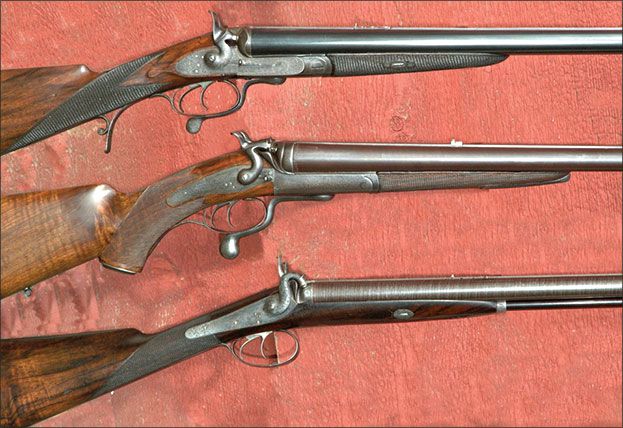
Thomas Kennedy 14-BorePercussion Double Rifle, $12,500
This rifle was made between 1841-1849, and is in entirely original condition. The bores and the rifle’s wood and metal finish are in very fine condition. The engraving is quite stunning, with a three-dimensional quality. The action also has numerous animals engraved on it. There are two tigers, a leopard standing on a snake, a stag or roebuck, and an Indian elephant. All the engravings are detailed, crisp and clean. The hammers and lock plates retain essentially all of their original case coloring. The hammer heads have eyes and scales. Are these dolphins? Dragons? They are lovely, at any rate. All of it is about 170 years old.
The locks are crisp, and the hammers stand equal when cocked or at rest — as they do on all three rifles. The quality of the wood is exceptional, with dark figure. The wrist is checkered but not the forend area. The fit of wood to metal is essentially perfect. The ramrod is secured in its home beneath the barrels by the simple expedient of its having a slight curvature. Its tip is knurled so the rod may be easily rotated to a position where its curvature locks it beneath the barrels.
The 27-inch barrels are damascus in an early and simple but stout twist pattern, carrying the original pleasant light-brown finish that shows the pattern well. We found a few tiny marks in the barrel finish and a nick or two in the wood, but otherwise the rifle was in very fine original condition throughout. A simple way to examine the bores of muzzle-loaders is to drop a suitable cartridge inside, base side up, with aluminum foil wrapped over the base. Then shine a light down the bore and take a look. We saw shiny steel on the lands inside each barrel, and some minor pits in the bottom of the deep grooves.
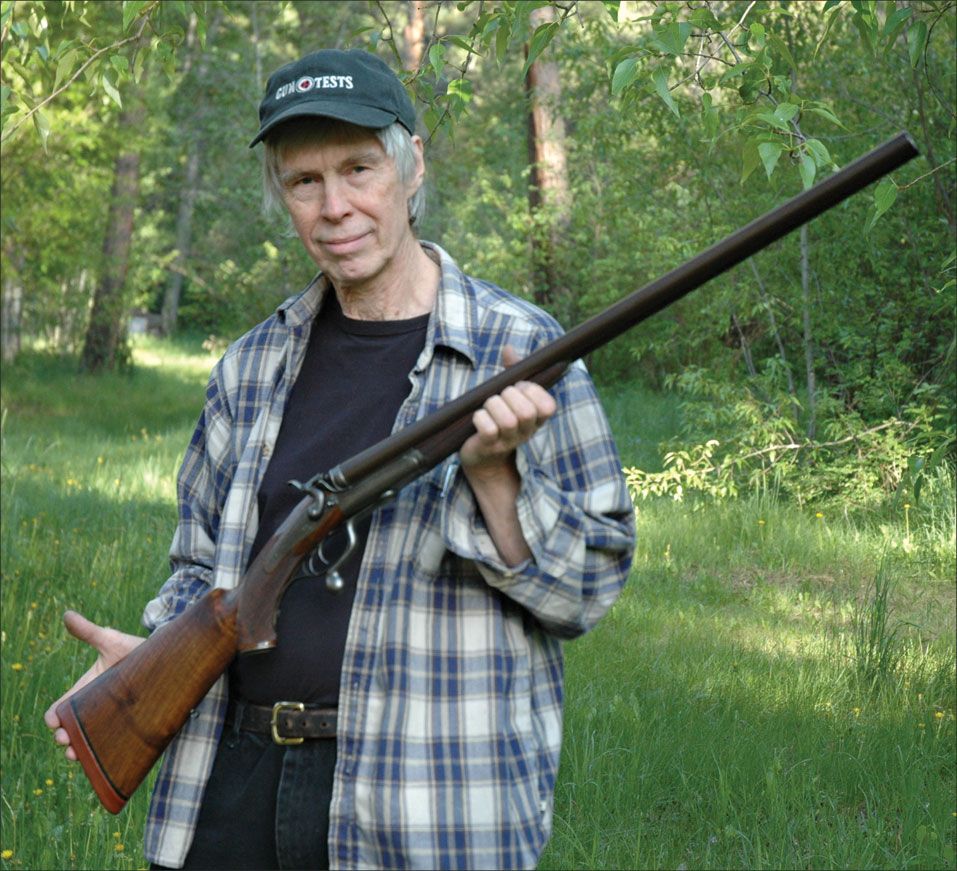
The top rib carried “T. Kennedy, Kilmarnock, Scotland,” followed by the splendid inletted three-leaf rear sight made of the same damascus metal as the barrels. The standing leaf was well regulated for 100 yards, as we proved on the range. In front of that were two leaves that fold down flush with the top of the rib. They were marked 150 and 200. The forward portion of the barrel had “Rifle Maker to His Royal Highness Prince Albert” engraved upon it. From Geoffrey Boothroyd’s Directory of British Gunmakers we know that Thomas Kennedy put that inscription on his rifles beginning in 1841, and went out of business — or died — in 1849, so the rifle was made within that time span. From the same source we learned that Mr. Kennedy was one fine rifle shot. In the mid-1840s a rifle match was shot between two men for 1000 guineas, a fabulous sum back then. Following the publication of the outcome of that match, Mr. Kennedy and some other fellows got together and Kennedy beat the match winner’s score a third better, using one of his own rifles. The match was 50 shots standing, fired at 150 yards. It seems that fine riflemen build fine rifles: Thomas Kennedy, John Rigby, etc. That’s one good reason the sights on this rifle are excellent. Also, if Prince Albert was a customer, well, that says quite a bit. Royalty didn’t buy junk guns.
The blued-steel butt plate of the rifle has another Kennedy’s name engraved into it, that of Lord David Kennedy, a keen sportsman for whom the rifle was apparently built. In 1859 Lord Kennedy made a hunt to the Spitzbergen area north of Norway, where he and a partner apparently did some market hunting of walrus, seal, etc. We don’t know if this rifle went on that expedition. If so, Lord Kennedy took exemplary care of his rifles, for there are no signs of what one might expect from using a black-powder rifle in salt-water environs for a several-months’-long expedition.
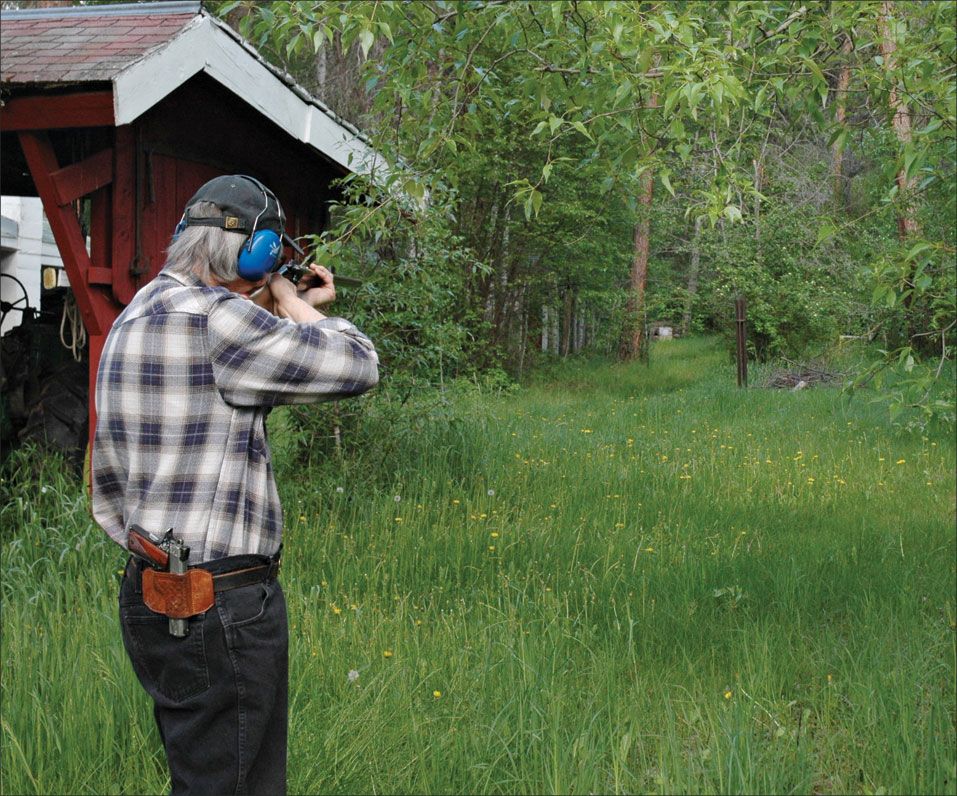
Here are some numbers to ponder. The rifle weighs 7.9 pounds, and its 500-grain ball at 1010 fps gives 1130 foot-pounds of energy. Recoil energy is 24 foot-pounds, somewhat more than a 7.5-pound 30-06 firing a 180-grain bullet at 2700 fps. After much experimentation, the present owner of the rifle arrived at a charge of 2.5 drams, which is about 68 grains, of FFFg Elephant brand powder for the Kennedy, and built a charger to hold it. We used that load, then rammed the 0.695-inch patched ball down on top of that. We used 0.015-inch lubricated patches, but wanted thinner ones to make loading easier. A number 11 CCI cap did the ignition chores, and the rifle responded very well. We found recoil to be significant but not so much as to require a soft recoil pad. Accuracy was all that we could ask, the two barrels printing on top of each other at 50 yards, and the sights were right on the money at 100.
Our Team Said:The rifle is in wonderful condition, and still has plenty of life left in it. It was fun to shoot, and we did not get tired of it. We wanted more, but ran out of time. The rifle’s weight and power seemed well matched. We could not fault this rifle, and our only complaint was that there are not many similar rifles out there for sale to get comparison prices. We found some clunkers online with exorbitant prices, so the value shown for this one seems to be well within reason.
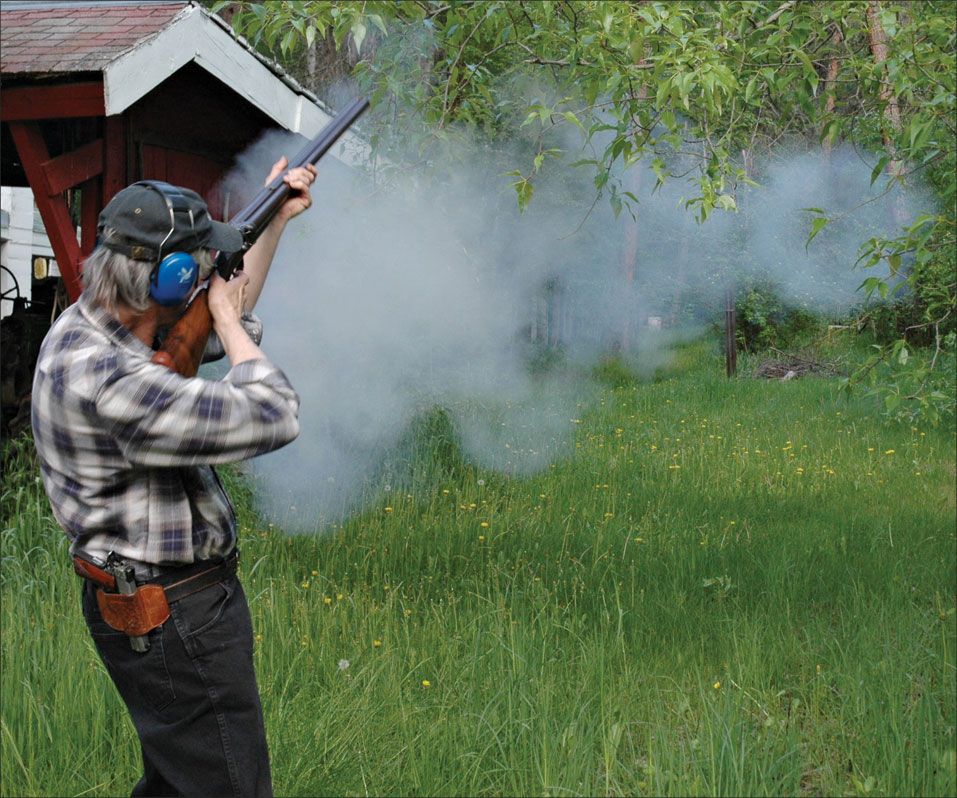
James Erskine 12-BoreDouble Rifle, $12,000
Our next rifle, the Erskine, was a fairly hefty one. It tipped the scales at 10.4 pounds, 2.5 pounds more than the Kennedy, which has similar power. We don’t know why it’s so heavy. We don’t think it was rebarreled. The 28-inch barrels (blued steel, not damascus) were reblacked by a skilled worker and appear to have been on the rifle since it was new. This rifle actually has less velocity but a touch more power than the smaller-bored Kennedy percussion rifle. A photograph of this rifle appeared in the 8th Edition of Cartridges of the World on page 340. James Erskine made fame for himself by designing a shotshell-loading machine that could load 1000 shells an hour. It eventually became used by all the British ammo makers. He also made firearms that won significant acclaim. This one bears his Newton-Stewart address on the barrel rib.
The Erskine is a sidelock rifle made around 1865 to 1870. The 28-inch barrels are in excellent condition and have 9-groove Henry rifling of a much more gradual twist than on the Henry rifle in this test. It has contoured fences, sprung strikers, and non-rebounding locks. The rear sight has a wide-angle vee standard sight and three folding leaves, all with a slim platinum line, for 200, 250, and 300 yards. The latter leaf stands way up in the air, in keeping with the rainbow trajectory of this old rifle. The front sight is an appropriate bead, dovetailed into the rib to provide windage adjustment. The locks were made by one J. Grainger, and feature a pierced bridle. They are in outstanding condition.
The hammers don’t have to be on half cock before opening the rifle, but must be put there whilst carrying the rifle loaded. Otherwise, the hammers would be pressing against the spring-loaded firing pins, putting them in direct contact with the primers. With the percussion rifle, the hammers obviously have to be carried off the caps once the rifle is loaded. The Erskine has “stalking safeties” that lock the hammers in place by means of a sliding block that has to be pushed forward before cocking the rifle fully for the shot. We thought it was a good idea to put the hammers on half cock and engage the stalking safeties before opening it.
The Alexander Henry has rebounding locks, so its hammers don’t have to be touched until you’re ready to fire. However, the Henry also has the “stalking safeties” for some reason. We have an idea why, which we’ll get to later. The Kennedy did not have them.
The Erskine has some of the finest wood we’ve ever seen. Yet for some reason, when the rifle came to its present owner the wood was covered with brown paint. The paint had a sort of swirling pattern as though to emulate fine wood grain. The owner removed all that paint, and was stunned to see what was underneath. Why the paint was put on there is a great mystery for which we have no solution, nor can we even speculate.
The locks are pristine inside and out, as is most of the rest of the rifle. The bores are in excellent condition with Henry rifling and no pitting. The lower tang forms a sort of pistol grip, a common feature of the time period when this rifle was made. The tip of it is checkered to give purchase while pulling the rifle into the shoulder. The butt plate is steel, with a touch of engraving on its top curve, though that area is slightly marred by age, and by contact with the ground.
The Erskine’s rear sight is a wide V with a slightly curved bottom. Without the platinum line we would have had trouble centering the front bead. The Erskine uses paper cases of 1.875-inch length. The loads given us were assembled with a 600-grain round ball. The charge is 55 grains (two drams) of FFFg Elephant powder with a thin card wad over the powder followed by two of the old Ox-Yoke lubricated Wonder Wads, and then the 0.735-inch cast lead ball roll-crimped into the case. This gives the 600-grain ball some 950 fps, which provides 1200 foot-pounds of energy. Recoil energy for the heavy Erskine was 19 foot-pounds. That of the much lighter Kennedy was 24 foot-pounds. That of the Henry was 55 foot-pounds.
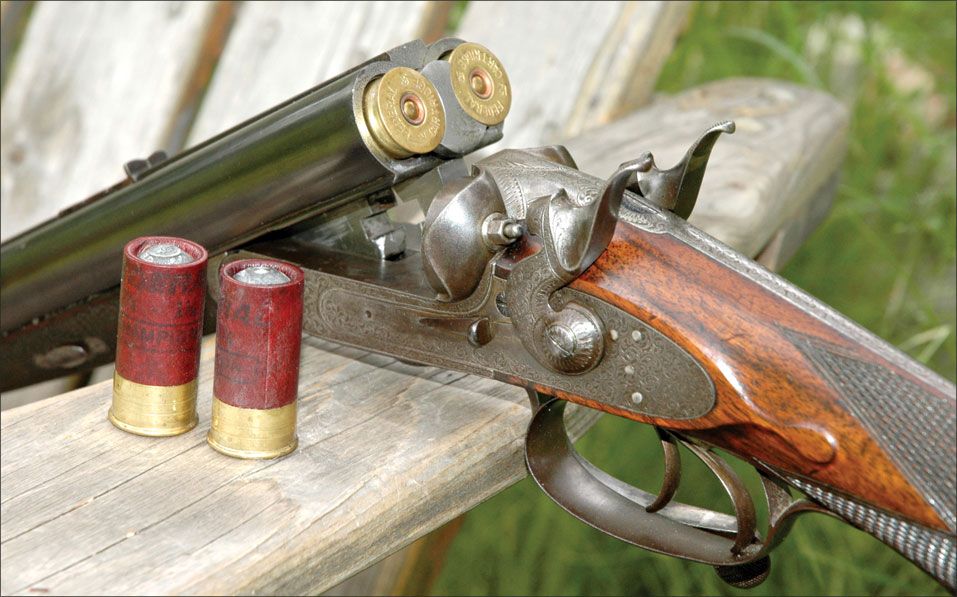
We fired the Erskine at 50 yards, and the rifle grouped very well. The shots landed nearly on top of each other, giving about a 1-inch spread, right to right and left to left. The height was close enough to our point of aim that we called it good. At 100 yards the rifle shot somewhat low, but made a four-shot group of 6 inches, with three of them inside 1.5 inches, and two of those were touching. Another try with the 200-yard leaf turned up put a right and a left 3 inches apart at about the right elevation. The rifle shot just above its sights at 50 yards, but dropped somewhat more than we thought it would at 100. It could be the rifle wants a lighter, hardened bullet. These would need a heavier powder charge to regulate, and would fly flatter, closer to the rifle’s sights at 100 yards. The owner told us hardened bullets of this same size weigh 540 grains, and would be what we’d try if we had time.
Our Team Said: We liked this rifle, though if it were made today we’d have it built a whole lot lighter. As it was, it had insignificant felt recoil and delivered excellent accuracy and quite a bit of power.
Alexander Henry 12-Bore Double Rifle, $8500
This was also a heavy rifle like the Erskine, but was much more powerful. The 2.5-inch cases of brass or paper take two to nearly three times the powder charge of either of the other two rifles with the 600-grain ball. Though showing signs of either heavy use or neglect in the past, the rifle remains sound throughout.
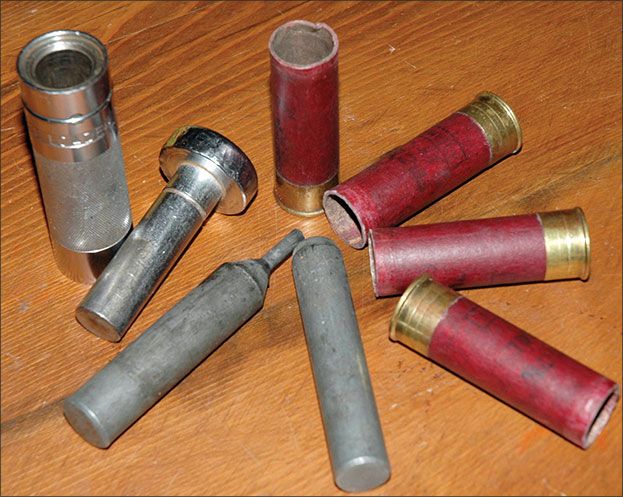
The 28-inch damascus barrels were shiny but slightly pitted from the effects of long use. The external surfaces of the action and locks were slightly pitted, and though the rifle was originally fully engraved, not much of the engraving detail can be made out. The Henry name is visible on each lock plate, and on the barrel rib as well. The barrels have been refinished in a deep brown, which we think looks great. The other metal parts appear to have been buffed or polished to remove rust.
There was some pitting inside the lock plates, but the moving parts and springs were in excellent condition. Each hammer cocked cleanly and they stood equal when cocked or at rest. The trigger pulls were crisp and quite light. In several tests we fired the left barrel with a full charge with the right hammer cocked on an empty chamber, and the hammer always remained cocked.
The wood has been refinished and recheckered, and both jobs were extremely well done. The wood fits the rifle perfectly, and the lock mortises are thankfully free of the common oil soaking one sees in older rifles. The cheekpiece has a good-looking step cut into its edge, something we’ve seen on other rifles by Alex Henry. The lockup is still tight, common with Jones-lever rifles. The firing pins are not bushed nor do they have retracting springs. They are big, like shotgun firing pins.
This rifle has rebounding locks along with stalking safeties. These safeties block the hammers from being moved until the safeties are shoved forward out of their detents in the hammer. While the use of stalking safeties is a good idea with non-rebounding locks, as on the Erskine, they are unneeded with rebounding locks like these, because the hammer cannot fly forward to touch the firing pin unless the trigger is pressed. However, on a rifle with serious recoil, which this one has, recoil combined with weary fingers that might get in the wrong position could inadvertently press the trigger for the second barrel, and the force of recoil could then move the hammer forward to fire the second barrel along with the first. So the prudent hunter had the option of using the stalking safety on the right barrel to positively keep it from firing. The left barrel is generally fired first by experienced riflemen to avoid the rifle kicking into one’s face as it twists in recoil. On this rifle, the right stalking safety is functional, but the left is either damaged or intentionally disabled.
We became quite fond of this rifle. The wood is attractive, the balance of the rifle is superb despite its ponderous weight, and the rifle gives us a sense of immense power. Really powerful rifles of this era generally began at 12-bore size and went up. Serious English rifles for Africa and India were commonly 8 bores and larger. A great many 12-bore rifles of the day were designed to fire round bullets, like the Erskine discussed above, or were “Paradoxes,” light enough to be shotguns but with rifling near the muzzle which gave the ability to shoot round-ball loads with acceptable accuracy out to significant range.
This one is different. It has a much faster rifling twist than the Erskine, and is thus designed to fire conical bullets of greater weight than round balls. A proper-size round ball for the dimensions of these barrels would weigh about 650-680 grains. A conical bullet could weigh 1000 grains or more, and would have enough space inside it to house an exploding charge. We shot the Henry quite a bit, though we never had perfect bullets for it. While finest accuracy was not exactly there, the recoil surely was. All our shots hit the paper, so we called it good.
Unfortunately we were unable to acquire any suitable bullets for the rifle. Its groove diameter was about 0.770, difficult to measure because of the odd number of grooves and lands and also the configuration of Henry rifling. The owner has tried cast-lead bullets of various weights turned in a lathe to the correct size, but had not made much progress in finding the best bullet weight. His tests led him to the opinion that the rifle needs a bullet in the 900 to 1000-grain range of 0.750-inch diameter and paper patched to fit.
We cut paper cases to 2.5 inches using an X-Acto blade against a dowel in a lathe. Using an ancient Lee Loader we knocked out the old primer and seated a new one. Then we poured in a weighed charge of 150 grains of FFFg Goex followed by an Ox-Yoke-lubricated 12-gauge wad and the ball. Then we shoved this assembly by hand into the Lee Loader, which pushed the case mouth inward with enough force to hold the ball in place. These shot well enough for us to get a feel for the rifle, and what a mighty brute it was. These loads whistled over our chronograph at over 1390 fps, which gave 2580 foot-pounds of energy.
Don’t be misled by the energy figures. A better comparison of their performance in the field might be gained by comparing the Taylor Knock-Out values for the three rifles, which Taylor never intended to be used on ancient rifles, but we did anyway. For the Henry, it’s 88. The Erskine makes 60, and the Kennedy, 43. By comparison, the 400 Jeffery gets about 47, and the 375 H&H Mag gets 40.
We tried a trick to test the rifle’s accuracy potential. We shoved a patched ball down the bore, stopping it at the very beginning of the rifling. Then we loaded a case with an extra wad to eliminate the space between ball and powder, and shot these from 25 yards. This gave us promising accuracy of less than 2 inches. If we owned this rifle we’d polish or fire-lap the bores and proceed with finding the best bullet and load for it.
Our Team Said: We became more fond of this rifle than of either of the other two, largely because of its great, stomping, booming horsepower. The still-soft original recoil pad kept us from getting bruised. We could happily shoot this rifle all day. If it were pristine as to the engraving, we suspect it would sell for twice the value shown here.
Written and photographed by Ray Ordorica, using evaluations from Gun Tests team testers. GT


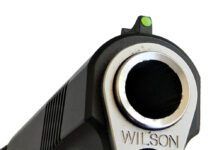

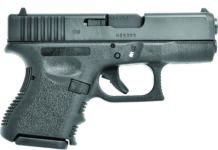
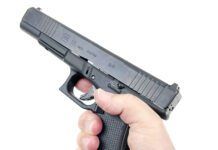


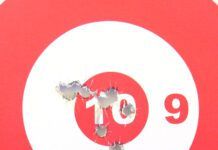


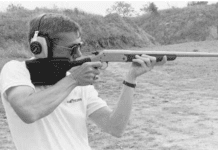







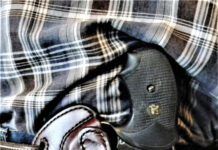

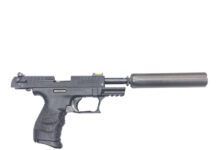




I would like to purchase this issue with the test of the 3 Scottish guns.
Could you let me know how I can do that.
Thanks for the information.